American Sabbatical 92: 4/13/97
Natchez Trace
4/13.. Natchez Trace.
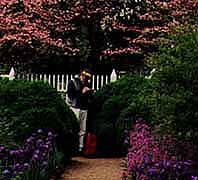
Garden Drawing
|
Raw and in the low 40s on a Nashville Sunday. We put all our layers back on and retreated
to the Hermitage, Andy Jackson’s place in his own bend of the
Cumberland. After bad-mouthing Old Hickory for the Cherokee removal,
we were now going to take advantage of his hospitality. Politicians
are used to that. |
The damp Norther nipped at us as we ambled through the park at
the Hermitage. Peggy went inside the brick mansion for the tour.
I roamed the gardens. Irises and columbines were out already,
but probably wishing they weren’t. I shivered my way through a
colored sketch. It gets harder to find a new angle to draw these
plantation houses from. The Hermitage, in particular is a full-face
kind of place. The two storied pillared facades stand out in front
of the building itself like false fronts, fore and aft, so the
profile looks a bit like a Western town. Makes sense, I suppose,
this WAS the wild West in Jackson’s day. Maybe that’s why they
all wear cowboy boots at the Opry.

Andy's Garden
Some grand trees in Andy’s yard, including a huge example of those
purple-blooming wonders we’ve been seeing along the road. This
one was identified as a Royal Paulownia. OK. The park is well
past maturity, and the old cedars and magnolias almost completely
obscure any long views. They weren’t blocking the wind this morning,
though. I was chilled stiff before the watercolor was dry. We
quick-stepped around the outbuildings, and made a break for a
warm Owl.
(Memo #85)
April 13 The Hermitage, Nashville
Who? Andrew Jackson, Seventh President, “Old Hickory”
What? his plantation outside Nashville, Tennessee
When? early 1800’s -1845
How? Jackson was a self-made man
Topics: frontier development, planter class, Jacksonian democracy,
Indian Removal
Questions: What does the Hermitage show about Jackson’s life? |
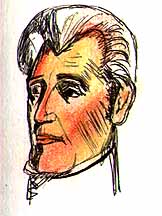
Old Hickory
|
I am fascinated by the winnowing process of history. Who makes
the cuts, whose fame endures? There are Americans who dominated
their eras, yet get somewhat shortchanged afterwards. If I ask
1990’s students to name “great” presidents, they name John F.
Kennedy, Abraham Lincoln, George Washington, Thomas Jefferson.
Sometimes Franklin Roosevelt. Only very occasionally does Theodore
Roosevelt get listed, or Harry Truman, or Andrew Jackson. (Then
we have a discussion about the concept of “great”).
This trip has really given us an ideal segue, from the preColumbian
sites of Georgia (Ocmulgee and Etowah), to the historic Cherokee
sites (New Echota, the Ross, Vann, Ridge houses), to the man who
removed the southeastern Indians.
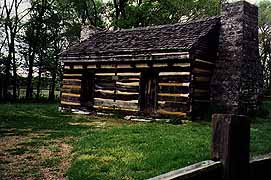
Hermitage Cabin
|
Andrew Jackson’s astonishing life is encapsulated in his city
(Nashville, Tennessee) and plantation (The Hermitage). Jackson
came though the Cumberland Gap in one of the earliest parties
and settled in Nashville when it was a log sided stockade. Today
a one quarter size model sits by the river framed against skyscrapers.
At the Hermitage, you can see the original log cabins that the
Jacksons used in the first years there, then the mansion itself
(the original redbrick federal, and the white columns, false front
and new wings of the successive renovations). His success as a
businessman and land speculator funded the plantation, his military
and government success brought the fame and visitors. He built
the Hermitage into an 1100 acre showplace where he raised horses
and cotton. He owned 130-150 slaves. |
The Hermitage is proof that a poor boy could attain the American
dream. Andrew Jackson was orphaned young. He was born before the
Revolution to poor Irish immigrants. He had no formal schooling,
but read law with a local lawyer. In the Revolution he scouted
for the Patriots. Detained by the British, he was ordered to shine
an officer’s boots. When the young man refused, the officer struck
him with his sword. Jackson carried scars on his cheek and ear
forever. This is said to have caused his hatred of the British
(given scope in the War of 1812). His negative feelings about
Native Americans are those of frontiersmen in a beleaguered settlement
such as Fort “Nashborough” where lone men out plowing might be
killed.
|
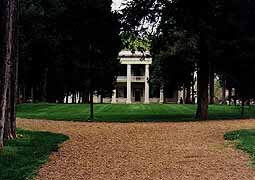
Hermitage
|
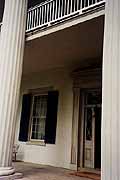
Front Door
|
Jackson’s career flourished as Nashville and Tennessee did. He
was the public prosecutor of Nashville, helped write the state
Constitution, served as Representative and then Senator from Tennessee
in Washington, came home to serve on the Tennessee Supreme Court
and head the state militia. In the War of 1812 he lead a combined
American-Cherokee force against the Creeks at the Battle of Horseshoe
Bend and became a national hero in the Battle of New Orleans.
Later he led an expedition into Spanish Florida and became first
Territorial Governor.
Jackson married Rachel Donelson, the daughter of the man who lead
the first settlement group to Nashville. “His devotion to his
wife is the gentlest thing is his life,” said one contemporary.
Frontier communication was bad and it turned out she was not officially
divorced at the time of their wedding ceremony. This became the
basis for a huge and vicious presidential election scandal in
1828 as well as Jackson’s many duels. The scandals are said to
have killed Rachel (two weeks before Jackson left for his inauguration).
We didn’t tolerate a divorced president until Ronald Reagan! |
All the time he was building his fortune through land speculation
and cotton and becoming part of the planter class. Although labeled
a rough frontiersman by his opponents, a visitor to the Hermitage
said Jackson’s “ manners are perfectly easy and polished”.
The Hermitage has the most imposing entrance buildings of any
presidential home we’ve seen, with the requisite gift shop and
small museum, also an auditorium and cafe. The mansion is reached
by a walk through park land and trees. It seems quiet and isolated
from modern intrusions and a lovely way to first see the house.
At the Hermitage, you take a self-tour with an individual tape
recorder. |
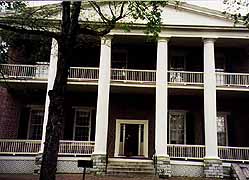
Back Door
|
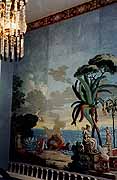
Mural
|
The Hermitage is apparently the presidential home with the most
original furnishings (90%), so there were none of the usual double
talk (“furnished with what WOULD have been usual furniture of
the era” ). The rooms are high ceilinged and beautifully furnished.
There is heavy upholstered wooden furniture, ornate wallpaper,
curtained beds, heavy drapes. There is crystal and silverware
and china in the pantry and on the diningroom table. Portraits
of Jackson and his family hang everywhere (Rachel’s portrait is
opposite his bed where he could see it first thing in the morning).
Every doorway is blocked with glass. The rooms all have enough
personal objects so they seem inhabited. The large central hallway
has a grand curving staircase, a crystal chandelier and French
wallpaper with classical scenes. There are two parlors, a huge
diningroom. Jackson’s bedroom and study downstairs. Upstairs there
are four more bedrooms. In his retirement Jackson regularly had
forty guests in the house! The guide noted that the furniture
was bought from the family and placed with the help of Jackson’s
man servant “Uncle Alfred” (who lived until 1901 and is buried
near the Jacksons in the garden). |
|
The renovations (which greatly increased the house’s size) and
furnishings were done primarily by Jackson’s daughter-in-law while
he was in the White House. Daughter in law? Interesting that all
my readings have avoided mention of family. Some presidents have
fairly anonymous families while the T. Roosevelt children, Lincoln
boys, and John-John are national icons. Remember the antics of
“Brother Billy” Carter? Andrew and Rachel adopted a child (from
a branch of the family). Andrew Jackson Jr., his wife, and their
three children lived at the Hermitage and the son managed the
plantation during his father’s presidency. He later wracked up
huge debts. |
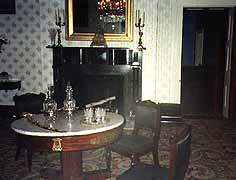
Furnishings
|
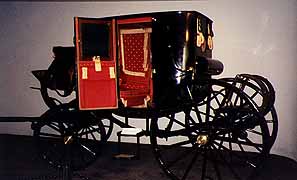
Jackson's Carriage
|
It is a beautiful and gracious house, and was kept by at least
ten house slaves.The huge garden - Rachel’s particular joy - is
adjacent and the irises and columbine were out as were the dogwoods.
The Jacksons' shared tomb and the small family graveyard are in
a corner of the garden.
Visitors can tour the cookhouse adjacent to the mansion, the smokehouse,
Uncle Alfred’s log house a hundred yards away, two original cabins
used by the Jackson’s and the brick church. I did not get a feeling
for the full plantations or the lives of the slaves (at Mt. Vernon
wash house and barns and overseer quarters were extant). |
| There are few souvenirs of Jackson’s colorful life. He was extremely
controversial. Attacked as an “adulterer” and “bigamist” (Rachel’s
divorce) and a “murderer” (his duels), he championed the rights
of the ordinary (white) man against the power of the educated
eastern elite. “Jacksonian Democracy” is the phrase historians
use to describe the extension of suffrage to include the average
man (the property qualification for voting disappeared). He is
the father of the Democratic party. He was a strong president
(1829-37) who used the veto power more than all his predecessors
together. |
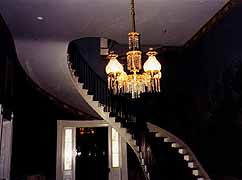
Staircase
|
Jackson destroyed the National Bank, and established the “spoils
system” and a kitchen cabinet to include more Americans in government.
He stood up to South Carolina, and threatened army intervention
when the state touted secession during a tariff struggle (Lincoln
was to try the same tactic in 1861). He sent the Army in to remove
the southeastern Indians even though the Supreme Court supported
their rights! The introductory movie mentioned that Jackson had
sent a Cherokee orphan to the Hermitage after the battle of Horseshoe
Bend (“I feel an unusual sympathy for him,” Jackson wrote). The
Hermitage is proof that Jackson successfully joined the southern
planter class and enjoyed all its benefits.

Peggy's Hermitage
4/14.. cont.
Then we enjoyed another 5-star meal. The Loveless Cafe and Motel out on the western fringe of the
urb was a promised gustatory delight, and we figured it must be
when the line was 45 minutes long even at 2 PM. So we sat in the
motel lot until our number came up, then crammed into the plain
and simple diningroom. Three actually, looking to be small rooms
of an old house with the partitions torn out. The original watercolors
on the walls were of old trucks and gas stations and other roadside
attractions. Quite good. The food was even better. Ham and biscuits,
black-eyed peas with fried corn bread and molasses, grits and
green beans. Complete repletion.
But dessert was the best. The Loveless is an hundred yards from
the north end of the Natchez Trace Parkway, and we contentedly
Owled onto that roadway, unsuspecting. It may be the most beautiful
road in America. The Lochse wilderness road through the sawtooth
mountains of Idaho, or the California coast road out of Ferndale,
may be grander but the Trace has a gentle rolling loveliness,
and no log trucks breathing down your neck. No trucks at all.
Forty or fifty mph speed limits. No utility pole and lines. And
this gray Sunday we had it all to ourselves.
Sashaying down the idyllic two lane between tall groves of hardwoods..
oaks and maples and tupelos and gums and beeches and chestnuts
and every kind of temperate broadleaf you can imagine.. just coming
into leaf. Under the myriad pastel greens of the canopy, explosions
of dogwood blossoms illuminate the understory, far into the diminishing
distance between the aisles of gray trunks.
| It’s easy to move out of time here, and imagine ourselves traveling
the trace in the days before steam. Back then river boatmen would
guide their flatboats and rafts down the Cumberland and Ohio and
Tennessee, into the Mississippi to New Orleans, where they’d sell
everything, boat and all. Poling and cordelling were the only
ways to fight back upstream. Some crews did that, and they were
the bragging kings of the rivers. The proverbial Mike Finks: half
horse, half alligator. Most crews sold out or were paid off in
the delta, and set off for the frontier settlements upstream via
the Trace. The foot highway from the French and Spanish stews
of New Orleans and Natchez to the American outposts in the original
Old West. |
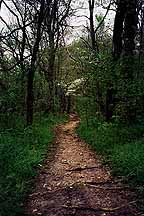
Old Natchez Trace
|
Sometimes a pair of travelers would buy one horse and ride-and-tie
their way to Nashville. One man would start riding in the morning,
tie the horse around mid-day, and walk on. The other would walk
until he met up with the horse, then ride to where his partner
had made camp. Then they’d trade off the next day. There are days
when this might be better for us, too. I could leave the Owl half
way to Memphis, perhaps...
There are no adverts on the Trace Parkway, just directional signs
at the infrequent crossings.. and brown information signs every
couple of miles. I’m beginning to think this journal should be
called Brown Roadsigns. The Trace is an historical encyclopedia,
and you might spend all day just reading the footnotes. As it
was we only made about 20 miles the first hour.
We couldn’t resist stopping to walk a section of the original
Trace. The woods climbing down the ridge beside us were totally
still . No squirrels. No birds. Even the wind had flunked out,
and faint hints of blooming fragrance crossed our path.. and the
smell of fresh horse manure. Somebody ride-and-tying maybe. The
forest floor was carpeted in places with violets. We heard a hound
baying way off in some holler.
Now and then the Trace crossed a declivity. The State of Tennessee
has built soaring flyovers for the Parkway, and you look down
on pocket farmsteads on the valley floors, or tucked into the
folded terrain. When the scenic highway goes under a crossroad
it’s through a graceful cement arch, as easy on the eyes as the
scarf-dancing hills. The guard-rails are zigzags of traditional
split rail fence.
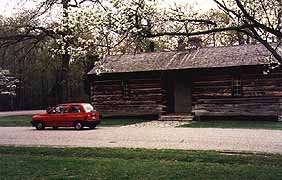
Meriwether's Last Stand
|
Just south of Gordonsburg on the Trace is where Meriwether Lewis
died so mysteriously. We had read Undaunted Courage in January,
the most recent retelling of the Lewis and Clark story. It left
me with the impression that Lewis ended up a self-important drunk,
who couldn’t face the grunt work of editing his journals. The
adulation he received after his epic adventure had spoiled him
for mundane tasks, or maybe the adventure itself made them seem
too petty. His death was portrayed as almost a grateful escape
from a sorrier fate. Then again, I came away disliking the author
intensely, with all his self-important pontifications, and now
wonder if I wasn’t simply glad the book was over when Lewis died.
|
The projections of biographers throw weird shadows on history,
and the Jeffersonian era has been badly served in our time. I’ve
had trouble admiring Jefferson ever since I read Dumas Malone’s
gigantic exercise in canonization. Malone spends so much time
defending Jefferson from the petty affronts of previous generations
that I was heartily sick of both of them by volume three. Jefferson
acquired the fussy prissiness of Malone. Maybe I’ll change my
mind at Monticello. And Undaunted Courage makes it hard to like
Lewis.
History is the mirror of ourselves. So we must retell it every
generation. The versions of the story told in any age are a window
into that time, and we can’t separate “real” history from contemporary
prejudices and concerns. There’s no more “objective” history than
there is objective journalism. Right now we are fixated on data.
The more details we can amass about a person or his time, the
more we KNOW. And the first person style of reportage means we
can’t follow Lewis to his sad end without suffering through all
the personal musings of a pompous academic. Makes you wish contemporary
writers would stand a bit farther back. Present company excepted,
of course. But back to the Trace.
The sun broke through just once on Sunday: as we pulled off into
the field where Meriwether Lewis is buried, beneath a simple monument...
a broken axle. There’s something happily symmetrical in Lewis
lying beside this historic footpath, set out of time. DeVoto in
his magnificent grove of cedars in the Lochse, and Lewis among
the chinquapins beside the Trace.
Eventually we had to return to the 20th century, but even along
Rt. 64 the curvilinear topography was easy on the eye. We did
intersect sections of clearcut, the only logging done anywhere
anymore, it seems. And there were trailers loaded with fresh felled
sticks parked along the way, waiting for the Monday mill openings,
I assumed. I deduce that these are independent logrigs, and loggers,
working through the sabbath and loading their spare trailers for
a cash bulge on Monday.
For the second time in a week we met with the aftermath of a tornado.
Ripped and ravaged swaths where trees are uprooted and houses
disintegrated, surrounded by untouched pastoral. Acts of God,
while the neighbors go calmly about their business. Or so it seems.
We sped on, only looking over our shoulders now and then. Every
few miles the roadside flowers would change. A carpet of purples,
then a white mist, then acres of daisies. We leveled out in the
Tennessee valley at Savannah, and bivouacked across the water
from Shiloh.













